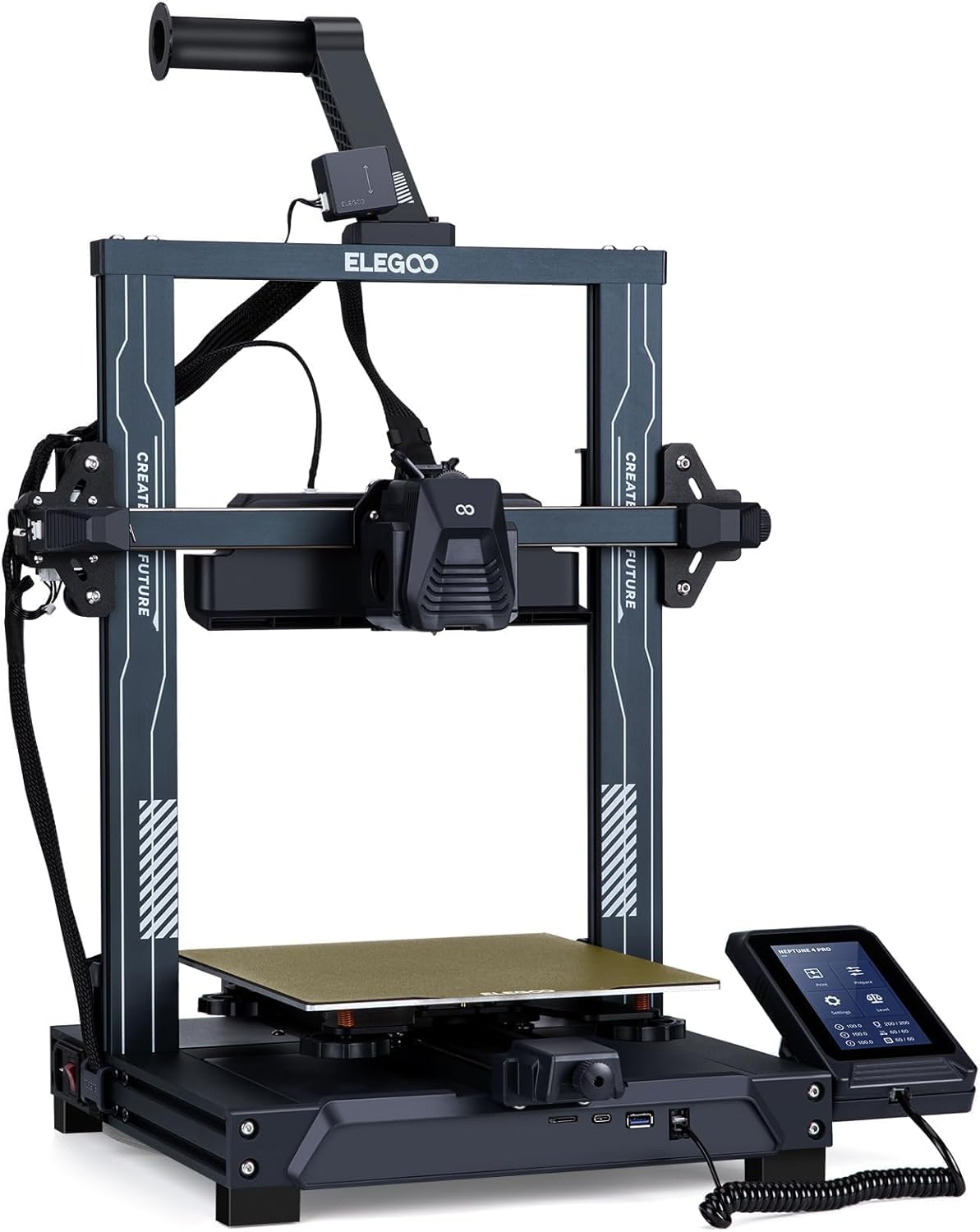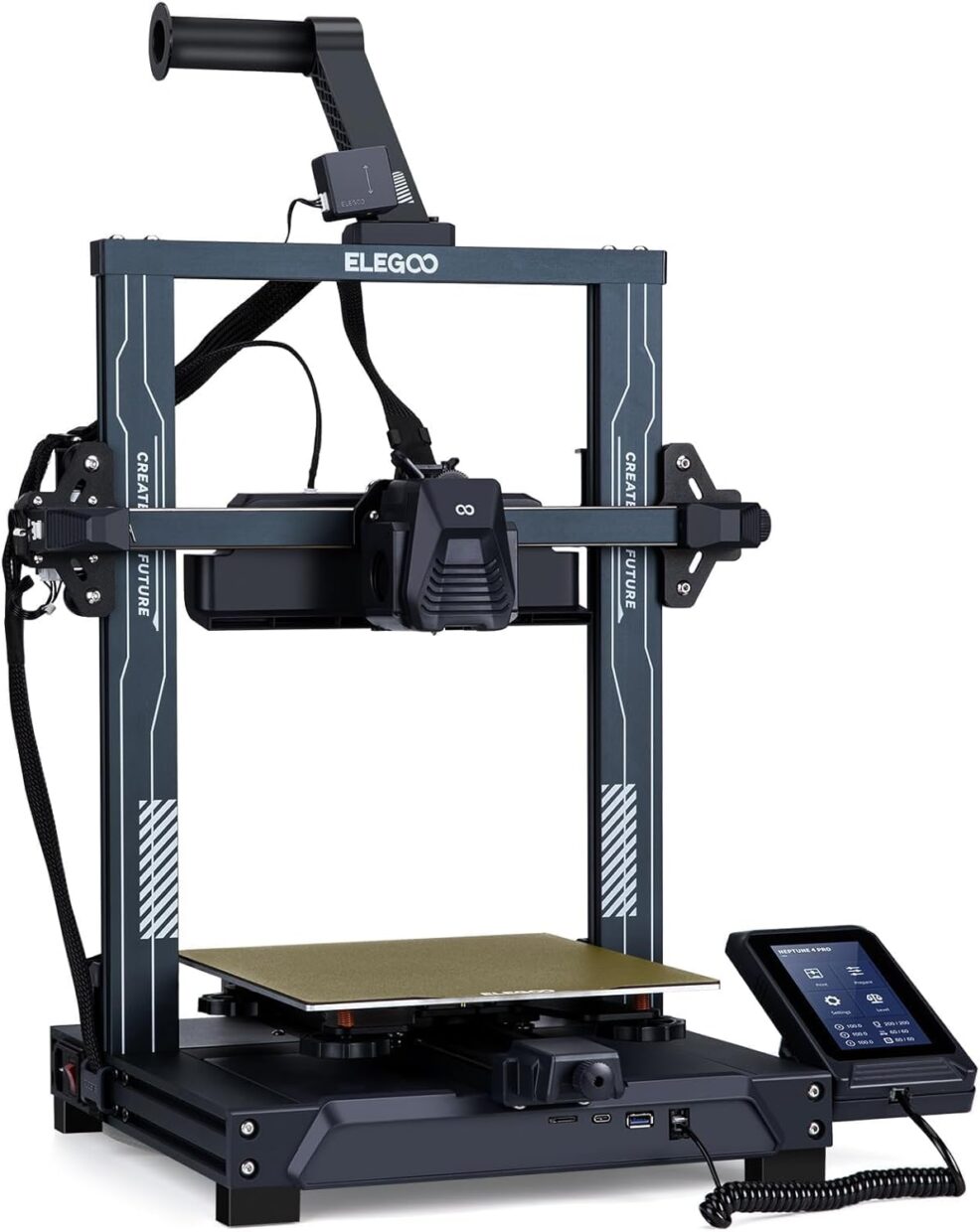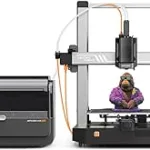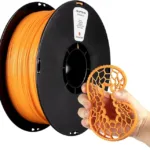
- arrow_back Home
- keyboard_arrow_right 3D Printers
ELEGOO Neptune 4 vs. Creality Ender 3 V3 Plus: The Ultimate 3D Printer Showdown

3D Printers3D Printing Chris Wyatt 30 August 2024
When choosing a 3D printer, several factors come into play to determine which model best suits your needs. The ELEGOO Neptune 4 and Creality Ender 3 V3 Plus are two popular options in the market, each offering a variety of features designed to enhance the 3D printing experience. In this comparison, we’ll delve into key aspects such as printing speed, build volume, extruder types, and more to help you make an informed decision.
The ELEGOO Neptune 4 is known for its impressive 500mm/s maximum printing speed, courtesy of its Klipper firmware and advanced ARM 64-bit processor. Meanwhile, the Creality Ender 3 V3 Plus takes it a step further with a remarkable 600mm/s speed, facilitated by its CoreXZ and Y-axis dual motors. Both printers offer high-speed printing capabilities, but the Ender 3 V3 Plus holds a slight edge in this category. Additionally, build volume is another critical factor, where the Ender 3 V3 Plus again outshines the Neptune 4 with a significantly larger build area, providing greater flexibility for larger projects.
ELEGOO Neptune 4
For
- High 500mm/s speed
- 300°C nozzle temp
- Dual-gear extruder
- User-friendly assembly
- Affordable price
Against
- Smaller build volume
- Manual fine-tuning needed
- No exact cooling specs
- Limited to 121-point leveling
- Potential vibration issues
Creality Ender 3 V3 Plus
For
- 600mm/s speed
- Large build volume
- Robust extruder design
- Easy auto calibration
- Advanced cooling fans
Against
- Higher price
- Unspecified nozzle temp
- Assembly required
- Bulky size
- Complex for beginners
Comparison of Printing Speed for ELEGOO Neptune 4 and Creality Ender 3 V3 Plus 3D Printers

The ELEGOO Neptune 4 boasts an impressive maximum printing speed of 500mm/s, thanks to its Klipper firmware and advanced ARM 64-bit processor. This high-speed capability significantly reduces the time required for printing tasks, making it an efficient choice for users who need to complete projects quickly.
On the other hand, the Creality Ender 3 V3 Plus surpasses the Neptune 4 with a remarkable maximum printing speed of 600mm/s. This enhanced speed is facilitated by its CoreXZ and Y-axis dual motors, allowing it to print up to 12 times faster than a regular 3D printer. This feature makes it particularly beneficial for prototyping and small-batch production, where time efficiency is crucial.
While both printers offer high-speed printing, the Creality Ender 3 V3 Plus has a slight edge over the ELEGOO Neptune 4 due to its higher maximum speed. However, the Neptune 4 still provides a very competitive speed that will meet the needs of most users.
ELEGOO Neptune 4
Creality Ender 3 V3 Plus 3D Printer
Comparing Build Volume: ELEGOO Neptune 4 vs. Creality Ender 3 V3 Plus
Build volume is a critical factor when choosing a 3D printer, as it determines the maximum size of the objects you can create. The ELEGOO Neptune 4 offers a build volume of 225x225x265mm, which is suitable for a wide range of projects, from small prototypes to medium-sized models. This capacity is ample for most hobbyists and those just starting with 3D printing.
On the other hand, the Creality Ender 3 V3 Plus boasts a significantly larger build volume of 300x300x330mm. This 58% increase compared to the Neptune 4 allows for the creation of larger models and more extensive projects without the need for multiple parts. The expanded build area is ideal for users looking to print life-size items or batch print smaller parts efficiently.
While both printers offer impressive build volumes, the Creality Ender 3 V3 Plus clearly outshines the ELEGOO Neptune 4 in this category. Its larger build volume provides greater flexibility and creative possibilities, making it a superior choice for those who need to print larger or more numerous items in a single run.
ELEGOO Neptune 4
Creality Ender 3 V3 Plus 3D Printer
Comparison of Extruder Types in 3D Printers

The ELEGOO Neptune 4 and Creality Ender 3 V3 Plus both feature direct drive extruders, which provide a significant advantage in terms of filament control and extrusion precision. Direct drive extruders are known for their ability to handle flexible filaments like TPU more effectively than Bowden setups. This makes both printers suitable for a wide range of filament types, offering versatility to the user.
The Neptune 4 boasts a self-developed dual-gear direct drive extruder with a 5.2:1 reduction ratio. This setup ensures powerful extrusion and smoother filament feeding, reducing the risk of nozzle clogging. The dual-gear design contributes to a more consistent and reliable printing experience, especially with materials that require precise flow control.
On the other hand, the Ender 3 V3 Plus features a robust direct drive extruder enhanced by a bolster spring and a ball plunger. This design provides over 1000 hours of clog-free extrusion, gripping the filament tightly without slackening. The addition of a side spring bolsters the grip of the extruding gears, further ensuring consistent filament flow.
In terms of ease of maintenance, the Ender 3 V3 Plus provides a more user-friendly approach with its tri-metal ‘Unicorn’ nozzle, which is quick to swap and easy to disassemble. This feature simplifies the maintenance process and extends the service life of the extruder components.
Both printers are equipped with advanced features that enhance the overall printing experience. The Neptune 4’s innovative air duct design and metal throat pipe minimize the risk of nozzle clogging, while the Ender 3 V3 Plus’s dual fans ensure rapid and even cooling of freshly printed sections, reducing issues like warping and stringing.
ELEGOO Neptune 4
Creality Ender 3 V3 Plus 3D Printer
Comparison of Nozzle Temperature Capabilities
The ELEGOO Neptune 4 3D Printer features a high-temp nozzle that can reach temperatures up to 300°C. This allows it to handle a wide range of filament materials, including PLA, PETG, ABS, TPU, and even nylon. The ability to reach such high temperatures ensures faster melting and extrusion, which can significantly improve the quality and speed of prints.
On the other hand, the Creality Ender 3 V3 Plus 3D Printer also boasts a high-temp nozzle, though the exact maximum temperature is not explicitly stated. This model is equipped with a tri-metal ‘unicorn’ nozzle designed for smooth material discharging and long service life. The nozzle and throat adopt an all-metal integrated design, which helps in maintaining consistent high temperatures during printing.
Comparing the two, the ELEGOO Neptune 4’s clearly stated 300°C maximum nozzle temperature gives it an edge in terms of versatility and performance. The specified temperature capability allows users to confidently experiment with various filament types, knowing the printer can handle the required heat levels.
While the Creality Ender 3 V3 Plus is likely capable of high temperatures due to its robust design, the lack of a specific maximum temperature figure makes it slightly less transparent in terms of its capabilities. However, the innovative tri-metal nozzle and its features still make it a strong contender in the high-temp printing category.
ELEGOO Neptune 4
Creality Ender 3 V3 Plus 3D Printer
Comparison of Auto Leveling Features in 3D Printers

The ELEGOO Neptune 4 features a newly designed auto bed leveling system that uses 121 (11×11) points to ensure quick and accurate leveling of the build platform. This system significantly improves the first-layer printing, a crucial step for achieving high-quality prints. Additionally, users can manually fine-tune the leveling using the hand-twist knobs under the PEI magnetic platform, providing an extra layer of control.
On the other hand, the Creality Ender 3 V3 Plus offers a one-tap calibration system that includes auto Z offset and leveling. This feature simplifies the setup process, making it extremely user-friendly, especially for beginners. The auto calibration ensures everything is ready for printing without the need for manual adjustments, thus saving time and reducing the complexity involved in the initial setup.
ELEGOO Neptune 4
Creality Ender 3 V3 Plus 3D Printer
Comparing Cooling Systems of 3D Printers: ELEGOO Neptune 4 vs. Creality Ender 3 V3 Plus
The cooling system of a 3D printer plays a crucial role in determining the quality and success of printed models. The ELEGOO Neptune 4 features double-sided cooling fans with strong airflow designed to ensure comprehensive heat dissipation. This setup effectively cools down the newly deposited layers, reducing the risk of warping and ensuring a smoother finish.
In comparison, the Creality Ender 3 V3 Plus is equipped with two part cooling fans located at the front and back of the printhead. This arrangement rapidly and evenly cools the freshly printed sections, helping to prevent issues such as drooping, warping, or stringing. Additionally, the dynamic balancing of the printhead fans in the Ender 3 V3 Plus reduces vibrations, contributing to a more stable printing process.
ELEGOO Neptune 4
Creality Ender 3 V3 Plus 3D Printer
Ease of Assembly Comparison: ELEGOO Neptune 4 vs. Creality Ender 3 V3 Plus

The ELEGOO Neptune 4 is designed with beginners in mind, featuring an easy assembly process that requires minimal effort. The printer comes pre-assembled in modules, significantly reducing the time and complexity usually associated with setting up a 3D printer. Clear and concise instructions further streamline the process, making it accessible even for those who are new to 3D printing.
On the other hand, the Creality Ender 3 V3 Plus also boasts a user-friendly assembly process. This 3D printer arrives in highly pre-assembled modules, which means users only need to complete a few final steps to get the printer operational. The one-tap calibration and auto-leveling features contribute to a hassle-free setup, ensuring that the printer is ready to use almost immediately after unboxing.
While both printers prioritize ease of assembly, the Creality Ender 3 V3 Plus takes a slight edge with its more advanced auto-calibration and leveling system. This feature eliminates the need for manual adjustments, which can be daunting for beginners. The ELEGOO Neptune 4, though simple to assemble, may require some manual calibration to achieve optimal printing conditions.
In terms of documentation and support, both ELEGOO and Creality provide comprehensive guides and customer support to assist users through the assembly process. However, Creality’s extensive online community and resources offer additional support that can be invaluable for troubleshooting and tips.
ELEGOO Neptune 4
Creality Ender 3 V3 Plus 3D Printer
Extruder Material Compatibility
The ELEGOO Neptune 4 is equipped with a 300°C high-temperature nozzle, making it compatible with a wide range of filament materials such as PLA, PETG, ABS, TPU, and nylon. This versatility allows users to experiment with different materials for various applications, from simple prototypes to more complex and durable parts.
The Creality Ender 3 V3 Plus also boasts a high-temperature nozzle capable of handling multiple filament types. However, it specifically highlights its tri-metal ‘Unicorn’ nozzle, which ensures smooth material discharge and a long service life. This design makes it particularly suitable for high-speed printing while maintaining the quality of prints across different filament materials.
Both 3D printers offer robust extruders designed to reduce clogging and ensure smooth filament feeding. The ELEGOO Neptune 4’s dual-gear direct drive extruder and metal throat pipe enhance its ability to handle various filaments efficiently. Similarly, the Creality Ender 3 V3 Plus features a direct drive extruder enhanced by a bolster spring and ball plunger, ensuring consistent extrusion force and reducing the risk of clogging.
Considering the range of compatible materials and the extruder design, both printers are well-suited for users looking to explore different filaments. However, the Creality Ender 3 V3 Plus, with its specialized tri-metal nozzle, might have a slight edge in terms of longevity and efficiency during high-speed printing.
ELEGOO Neptune 4
Creality Ender 3 V3 Plus 3D Printer
Comparison of Software Features in 3D Printers

The software features of the ELEGOO Neptune 4 include advanced Klipper firmware which allows for a maximum printing speed of 500mm/s with 20000mm/s² acceleration. This makes it highly efficient for time-sensitive projects. The intelligent input shaping and pressure advance functions help in minimizing vibration effects and ensure precise flow control, significantly improving print quality.
On the other hand, the Creality Ender 3 V3 Plus utilizes Creality OS, which is an open-source operating system enabling many advanced functions such as linear advance and input shaping. This offers the user the ability to fine-tune settings in expert mode or with root access, allowing for a more customizable 3D printing experience. The software also supports remote printing via the Creality Print slicer and Creality Cloud APP.
Both printers offer auto-calibration features, which simplify the setup process. The Neptune 4 features a user-friendly auto-leveling system with 121 points, ensuring quick and accurate leveling of the build platform. Similarly, the Ender 3 V3 Plus offers one-tap calibration with auto Z-offset and leveling, making it convenient and easy for users to start their printing tasks.
In terms of user interface, the Neptune 4 boasts a straightforward and easy-to-navigate system, while the Creality Ender 3 V3 Plus provides a more robust interface through its open-source OS, making it more suited for users who prefer extensive customization options.
ELEGOO Neptune 4
Creality Ender 3 V3 Plus 3D Printer
Price Comparison of 3D Printers
Starting with the ELEGOO Neptune 4, this 3D printer is priced at £227.99. It offers a range of advanced features such as a high printing speed of 500mm/s and a 300°C high-temp nozzle. These features make it a cost-effective option for those seeking high performance without breaking the bank.
In contrast, the Creality Ender 3 V3 Plus is priced significantly higher at £499.00. While it does offer a larger build volume and a faster printing speed of 600mm/s, the higher price may not justify these additional features for every user. Budget-conscious buyers might find the ELEGOO Neptune 4 to be a more appealing choice.
ELEGOO Neptune 4
Creality Ender 3 V3 Plus 3D Printer
Final Conclusion on the Comparison of ELEGOO Neptune 4 and Creality Ender 3 V3 Plus 3D Printers
In this conclusion, we summarize the key points of the comparison and declare the Creality Ender 3 V3 Plus as the preferred choice based on the following reasons: its higher maximum printing speed of 600mm/s, larger build volume of 300x300x330mm, and advanced features such as the one-tap calibration system and dual fans for rapid cooling. These aspects make it superior in terms of time efficiency, flexibility in project sizes, and ease of use for both beginners and experienced users. While the ELEGOO Neptune 4 offers competitive features at a lower price point, the additional capabilities of the Creality Ender 3 V3 Plus justify its higher cost for those who prioritize speed, build capacity, and user-friendly setup. This decision aligns with the thematic concept of ‘Advanced 3D Printing Solutions,’ emphasizing the need for high performance and versatility in 3D printing technologies.
What is the maximum printing speed of the ELEGOO Neptune 4 and Creality Ender 3 V3 Plus?
The ELEGOO Neptune 4 has a maximum printing speed of 500mm/s, while the Creality Ender 3 V3 Plus can reach up to 600mm/s.
Which 3D printer offers a larger build volume, the ELEGOO Neptune 4 or the Creality Ender 3 V3 Plus?
The Creality Ender 3 V3 Plus offers a larger build volume of 300x300x330mm compared to the ELEGOO Neptune 4’s build volume of 225x225x265mm.
What are the extruder types used in the ELEGOO Neptune 4 and Creality Ender 3 V3 Plus?
Both the ELEGOO Neptune 4 and Creality Ender 3 V3 Plus use direct drive extruders. The Neptune 4 features a self-developed dual-gear direct drive extruder, while the Ender 3 V3 Plus has a direct drive extruder with a bolster spring and ball plunger.
Which 3D printer has a higher maximum nozzle temperature?
The ELEGOO Neptune 4 has a clearly stated maximum nozzle temperature of 300°C. The Creality Ender 3 V3 Plus also supports high temperatures, but the exact maximum temperature is not explicitly stated.
What auto leveling features do the ELEGOO Neptune 4 and Creality Ender 3 V3 Plus offer?
The ELEGOO Neptune 4 features a 121-point auto bed leveling system, while the Creality Ender 3 V3 Plus offers a one-tap calibration system with auto Z offset and leveling.
How do the cooling systems compare between the ELEGOO Neptune 4 and Creality Ender 3 V3 Plus?
The ELEGOO Neptune 4 features double-sided cooling fans for comprehensive heat dissipation, while the Creality Ender 3 V3 Plus has two part cooling fans located at the front and back of the printhead for rapid and even cooling.
Which 3D printer is easier to assemble?
Both the ELEGOO Neptune 4 and Creality Ender 3 V3 Plus are designed for easy assembly. The Creality Ender 3 V3 Plus has a slight edge with its advanced auto-calibration and leveling system, making it more user-friendly for beginners.
What are the price differences between the ELEGOO Neptune 4 and Creality Ender 3 V3 Plus?
The ELEGOO Neptune 4 is priced at £227.99, while the Creality Ender 3 V3 Plus is priced significantly higher at £499.00.
About Ultimate 3D
Learn everything there is to know about 3D Printers and the different components and printing materials.
Site Links
Copyright 2024 Ultimate 3D





Be the first to leave a comment